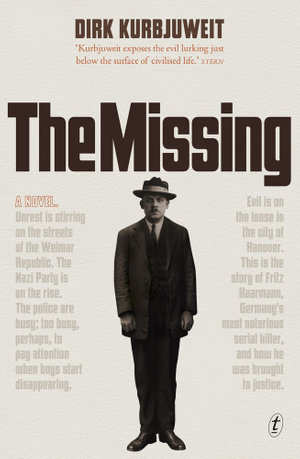The missing by Dirk Kurbjuweit

This book is set in Hanover in 1923, with the aftermath of World War I and the Treaty of Versailles casting a shadow over all. This fictional account is based on the life of Fritz Haarmann (also known as ‘The Butcher of Hanover’). Haarmann was convicted for the murders of 24 boys, and believed to be responsible for more. There is a memorial to the 27 known boys in Hanover. This book contains quotations from medical reports and Haarmann’s confession in its entirety. While there will be some readers who know how this story ends, the author has crafted a novel the delves into the thinking and attitudes of the times.
The novel (translated by Imogen Taylor) begins with Inspector Robert Lahnstein searching the archives for information about 10 boys who have gone missing. He has been charged with the responsibility for solving the cases and is struggling to make progress. There is pressure from his superiors and a lack of professionalism in his colleagues.
We are provided raw, uncompromising insight into the characters of Lahnstein and Haarmann. Lahnstein is an introspective man who is full of doubts and it is through his eyes that we have a clearer understanding of the 175ers and the homosexual cultural society in Hanover. The term 175ers was coined due to Paragraph 175 of the German criminal code which made homosexuality a crime. The reader is invited to consider these insights as residing within the complex political instability of the Weimar Republic.
Ethical understandings and responsibilities related to policing and justice are explored through Lahnstein’s interactions with his father (a retired policeman) and the incompetent Muller (Lahnstein’s subordinate). The reader is prompted to evaluate the role of the community in the deaths of the boys. This is a grim, and at times confronting, book. The detail is gruesome and the grief of parents palpable.
Themes: Serial Murder; Grief; Historical crime; Aftermath of war.
Linda Guthrie